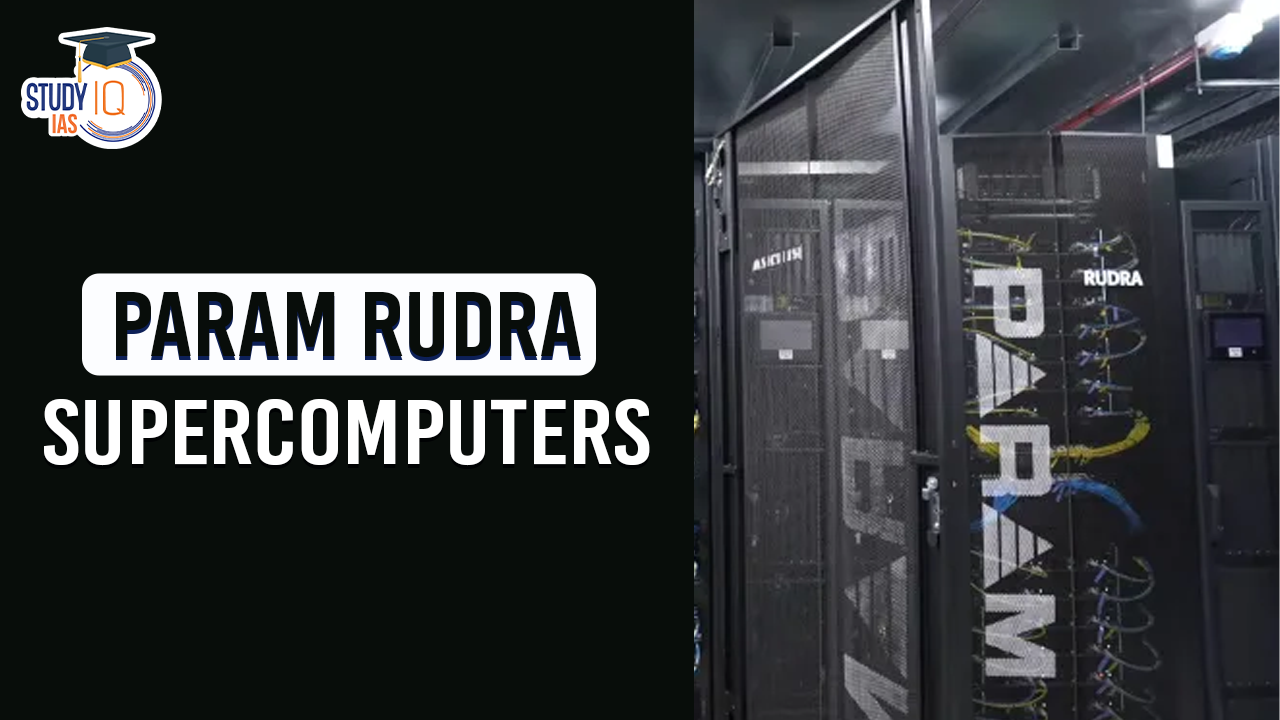Table of Contents
On September 27, 2024, Prime Minister Narendra Modi launched three PARAM Rudra supercomputers and a High-Performance Computing (HPC) system dedicated to weather and climate research. This initiative is a significant step towards enhancing India’s supercomputing capabilities and fostering technological self-reliance. The following article explores the features, significance, and implications of the PARAM Rudra supercomputers, making it a vital read for UPSC aspirants.
What is PARAM Rudra Supercomputers?
The PARAM Rudra supercomputers are part of India’s National Supercomputing Mission (NSM), aimed at strengthening the nation’s research capabilities in various scientific fields. Here’s a closer look at their features:
| Feature | Details |
|---|---|
| Launch Date | September 27, 2024 |
| Total Cost | Approximately ₹130 crore |
| Development | Indigenously developed under the NSM |
| Deployment Locations | Delhi, Pune, Kolkata |
| Applications | Weather research, material science, atomic physics, astronomy, physics, cosmology, and earth sciences |
Details About PARAM Rudra Supercomputers
1. Self-Reliance in Computing Technology
The launch of PARAM Rudra marks a crucial advancement towards self-sufficiency in supercomputing technology. This initiative reflects India’s commitment to reducing dependency on foreign technologies and enhancing indigenous capabilities.
2. Strategic Deployment Locations
The supercomputers have been strategically deployed at three key research institutions:
- Delhi:
- Inter University Accelerator Centre (IUAC)
- Focus: Material science and atomic physics research.
- Pune:
- Giant Metre Radio Telescope (GMRT)
- Focus: Exploring Fast Radio Bursts (FRBs) and other astronomical phenomena.
- Kolkata:
- S N Bose Centre
- Focus: Advanced research in physics, cosmology, and earth sciences.
3. Boosting Scientific Research and Innovation
The PARAM Rudra supercomputers will significantly enhance India’s research capabilities in various scientific domains. By providing advanced computational resources, these systems will facilitate:
- Accelerated Research: Faster data processing and simulations will lead to quicker insights and breakthroughs in scientific studies.
- Interdisciplinary Collaboration: Researchers across different fields can collaborate effectively using powerful computing resources.
- Support for MSMEs and Startups: The availability of supercomputing resources will also benefit Micro, Small, and Medium Enterprises (MSMEs) and startups involved in research and development.
Implications for India
The introduction of PARAM Rudra supercomputers has profound implications for India’s scientific community:
1. Enhanced Research Capabilities
With advanced computing capabilities, Indian researchers can compete on a global scale, conducting high-level simulations and analyses in various fields.
2. National Security and Strategic Planning
Improved weather forecasting and climate research can significantly contribute to national security and disaster management strategies.
3. Economic Growth
The supercomputing infrastructure can foster innovation in sectors such as agriculture, health, and climate studies, driving economic growth and development.
4. Educational Advancements
Institutions can incorporate high-performance computing into their curricula, enhancing the skills of students in science and technology.
Param Rudra Supercomputers UPSC
The launch of the PARAM Rudra supercomputers is a landmark achievement in India’s journey toward technological advancement and self-reliance. By investing in indigenous supercomputing infrastructure, India is poised to enhance its research capabilities significantly and contribute to global scientific advancements. For UPSC aspirants, understanding the implications of this initiative is crucial, as it reflects broader trends in technology, governance, and national development.


 Vitamin D Deficiency: Causes, Symptoms a...
Vitamin D Deficiency: Causes, Symptoms a...
 GAURAV: Long Range Glide Bomb (LRGB)
GAURAV: Long Range Glide Bomb (LRGB)
 Gestational Diabetes Mellitus (GDM), Cau...
Gestational Diabetes Mellitus (GDM), Cau...





















